Abstract
The antimalarial drug quinine has been shown to impair human polymorphonuclear leukocyte (PMN) functions. To gain insight into the mechanism of this phenomenon, we investigated quinine uptake by PMN with a fluorometric assay based on the fluorescence properties of this drug. After 30 min of incubation at 37 degrees C in the presence of 1 and 10 micrograms of quinine per ml, PMN-associated quinine reached 90 +/- 6 and 780 +/- 150 ng/2.5 x 10(6) PMN, respectively, giving a cellular-to-extracellular concentration ratio of 140 to 150. A steady state was reached within 5 min. Uptake was partially dependent on temperature, cell viability, and extracellular pH. Fractionation studies showed that 30 to 40% of the PMN-associated quinine was located in the particulate fraction. The efflux of PMN-associated quinine was rapid and complete when the incubation mixture was replaced by drug-free medium. These data suggest that several mechanisms are involved in the uptake of quinine by PMN, including a viability- and energy-independent process possibly related to reversible association of quinine to cell structures (particularly the membrane). Other mechanisms could involve trapping by protonation and/or active PMN transport systems. Thus, most of the quinine taken up by resting PMN is found in the soluble fraction of disrupted cells. This may partly explain the depressive properties of quinine.
Full text
PDF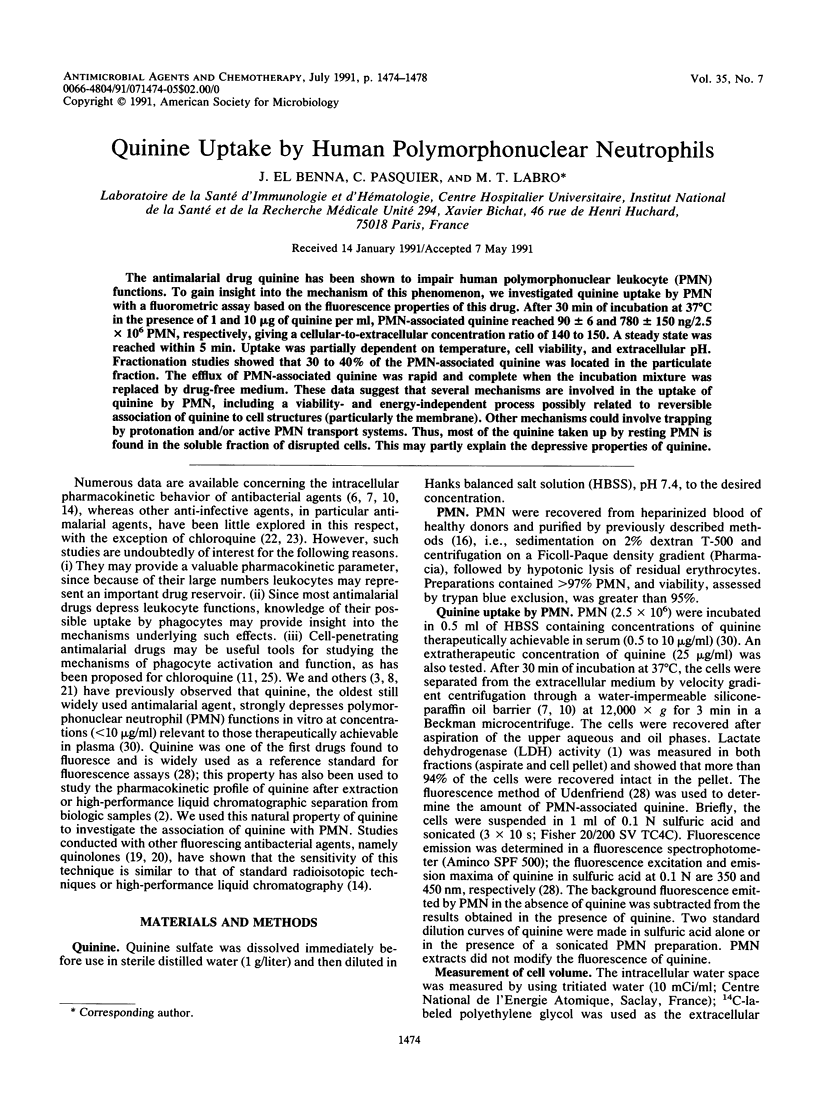
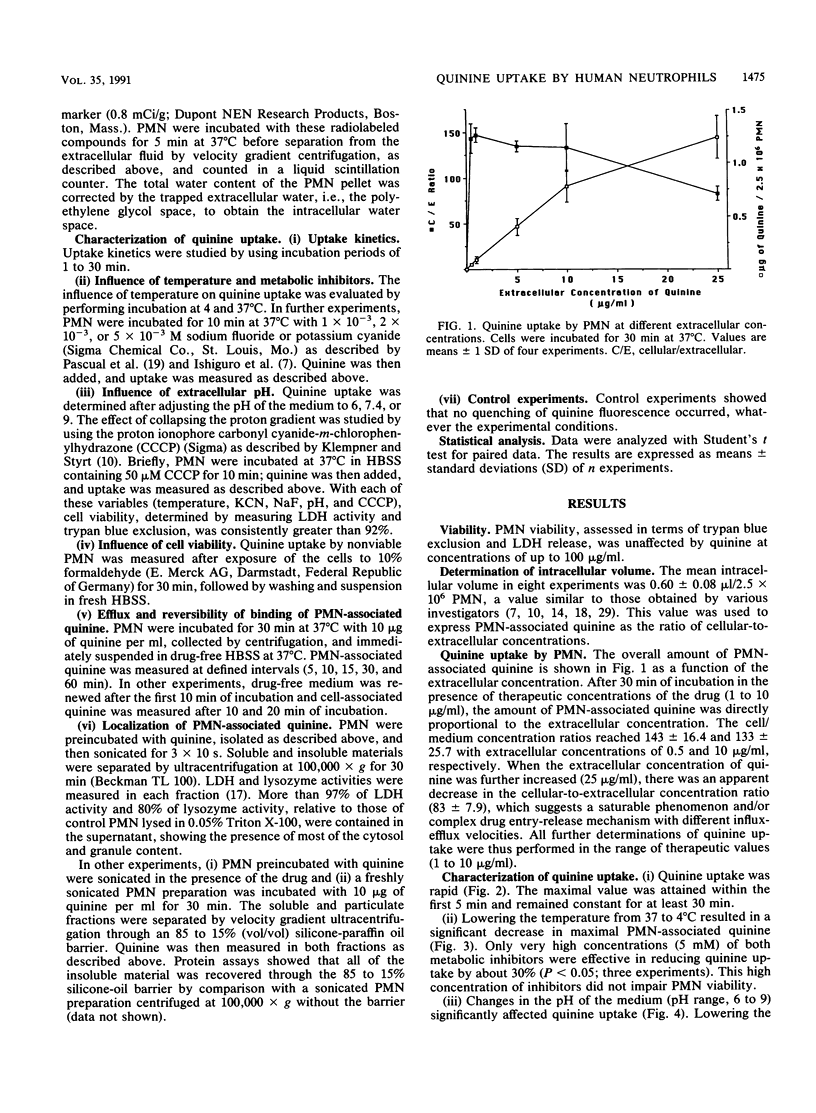
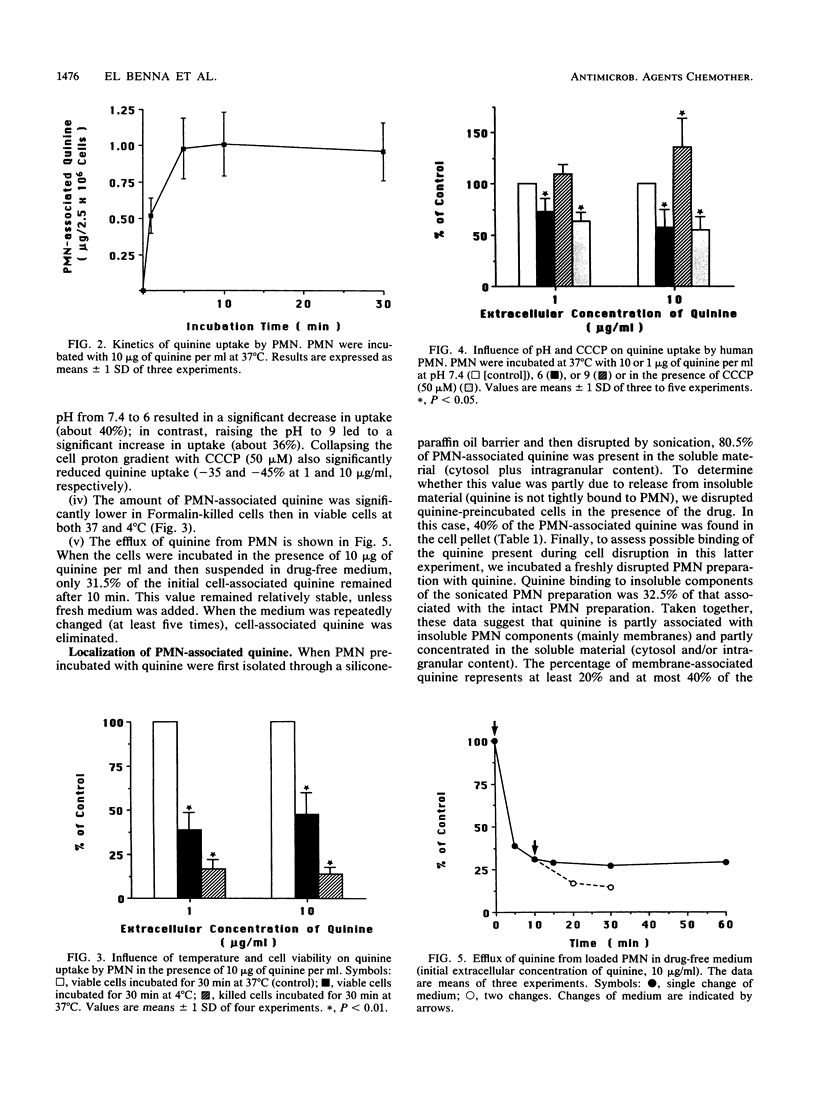
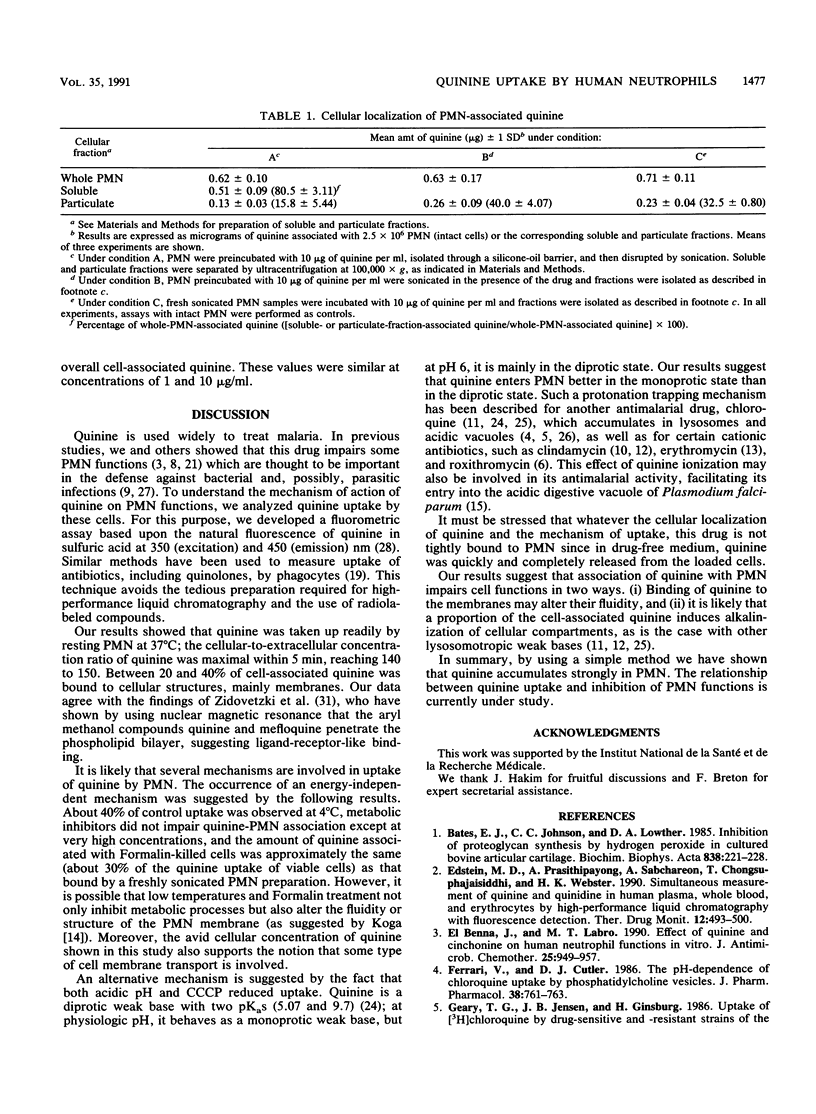
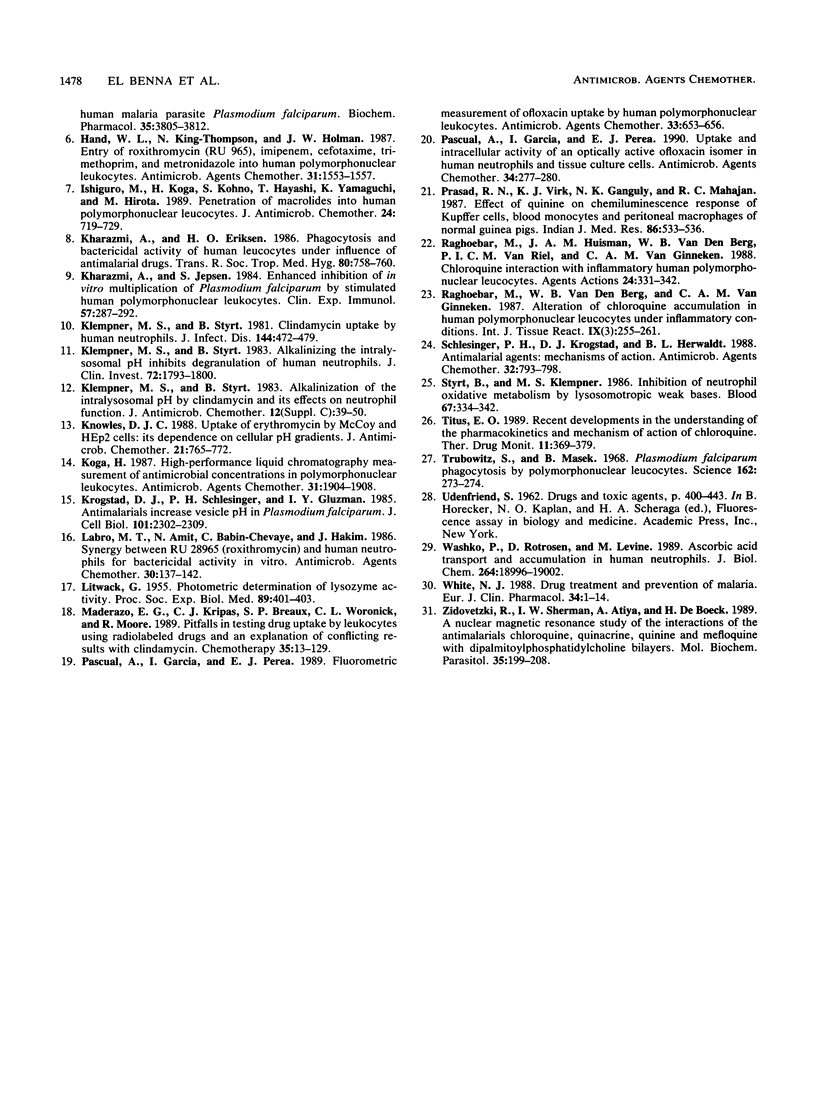
Selected References
These references are in PubMed. This may not be the complete list of references from this article.
- Bates E. J., Johnson C. C., Lowther D. A. Inhibition of proteoglycan synthesis by hydrogen peroxide in cultured bovine articular cartilage. Biochim Biophys Acta. 1985 Feb 15;838(2):221–228. doi: 10.1016/0304-4165(85)90082-0. [DOI] [PubMed] [Google Scholar]
- Edstein M. D., Prasitthipayong A., Sabchareon A., Chongsuphajaisiddhi T., Webster H. K. Simultaneous measurement of quinine and quinidine in human plasma, whole blood, and erythrocytes by high-performance liquid chromatography with fluorescence detection. Ther Drug Monit. 1990 Sep;12(5):493–500. doi: 10.1097/00007691-199009000-00015. [DOI] [PubMed] [Google Scholar]
- Ferrari V., Cutler D. J. The pH-dependence of chloroquine uptake by phosphatidylcholine vesicles. J Pharm Pharmacol. 1986 Oct;38(10):761–763. doi: 10.1111/j.2042-7158.1986.tb04486.x. [DOI] [PubMed] [Google Scholar]
- Hand W. L., King-Thompson N., Holman J. W. Entry of roxithromycin (RU 965), imipenem, cefotaxime, trimethoprim, and metronidazole into human polymorphonuclear leukocytes. Antimicrob Agents Chemother. 1987 Oct;31(10):1553–1557. doi: 10.1128/aac.31.10.1553. [DOI] [PMC free article] [PubMed] [Google Scholar]
- Ishiguro M., Koga H., Kohno S., Hayashi T., Yamaguchi K., Hirota M. Penetration of macrolides into human polymorphonuclear leucocytes. J Antimicrob Chemother. 1989 Nov;24(5):719–729. doi: 10.1093/jac/24.5.719. [DOI] [PubMed] [Google Scholar]
- Kharazmi A., Eriksen H. O. Phagocytosis and bactericidal activity of human leucocytes under influence of antimalarial drugs. Trans R Soc Trop Med Hyg. 1986;80(5):758–760. doi: 10.1016/0035-9203(86)90378-0. [DOI] [PubMed] [Google Scholar]
- Kharazmi A., Jepsen S. Enhanced inhibition of in vitro multiplication of Plasmodium falciparum by stimulated human polymorphonuclear leucocytes. Clin Exp Immunol. 1984 Aug;57(2):287–292. [PMC free article] [PubMed] [Google Scholar]
- Klempner M. S., Styrt B. Alkalinization of the intralysosomal pH by clindamycin and its effects on neutrophil function. J Antimicrob Chemother. 1983 Oct;12 (Suppl 100):39–50. doi: 10.1093/jac/12.suppl_c.39. [DOI] [PubMed] [Google Scholar]
- Klempner M. S., Styrt B. Alkalinizing the intralysosomal pH inhibits degranulation of human neutrophils. J Clin Invest. 1983 Nov;72(5):1793–1800. doi: 10.1172/JCI111139. [DOI] [PMC free article] [PubMed] [Google Scholar]
- Klempner M. S., Styrt B. Clindamycin uptake by human neutrophils. J Infect Dis. 1981 Nov;144(5):472–479. doi: 10.1093/infdis/144.5.472. [DOI] [PubMed] [Google Scholar]
- Knowles D. J. Uptake of erythromycin by McCoy and HEp2 cells: its dependence on cellular pH gradients. J Antimicrob Chemother. 1988 Jun;21(6):765–772. doi: 10.1093/jac/21.6.765. [DOI] [PubMed] [Google Scholar]
- Koga H. High-performance liquid chromatography measurement of antimicrobial concentrations in polymorphonuclear leukocytes. Antimicrob Agents Chemother. 1987 Dec;31(12):1904–1908. doi: 10.1128/aac.31.12.1904. [DOI] [PMC free article] [PubMed] [Google Scholar]
- Krogstad D. J., Schlesinger P. H., Gluzman I. Y. Antimalarials increase vesicle pH in Plasmodium falciparum. J Cell Biol. 1985 Dec;101(6):2302–2309. doi: 10.1083/jcb.101.6.2302. [DOI] [PMC free article] [PubMed] [Google Scholar]
- LITWACK G. Photometric determination of lysozyme activity. Proc Soc Exp Biol Med. 1955 Jul;89(3):401–403. doi: 10.3181/00379727-89-21824. [DOI] [PubMed] [Google Scholar]
- Labro M. T., Amit N., Babin-Chevaye C., Hakim J. Synergy between RU 28965 (roxithromycin) and human neutrophils for bactericidal activity in vitro. Antimicrob Agents Chemother. 1986 Jul;30(1):137–142. doi: 10.1128/aac.30.1.137. [DOI] [PMC free article] [PubMed] [Google Scholar]
- Maderazo E. G., Kripas C. J., Breaux S. P., Woronick C. L., Moore R. Pitfalls in testing drug uptake by leukocytes using radiolabeled drugs and an explanation of conflicting results with clindamycin. Chemotherapy. 1989;35(2):123–129. doi: 10.1159/000238658. [DOI] [PubMed] [Google Scholar]
- Pascual A., Garcia I., Perea E. J. Fluorometric measurement of ofloxacin uptake by human polymorphonuclear leukocytes. Antimicrob Agents Chemother. 1989 May;33(5):653–656. doi: 10.1128/aac.33.5.653. [DOI] [PMC free article] [PubMed] [Google Scholar]
- Pascual A., Garcia I., Perea E. J. Uptake and intracellular activity of an optically active ofloxacin isomer in human neutrophils and tissue culture cells. Antimicrob Agents Chemother. 1990 Feb;34(2):277–280. doi: 10.1128/aac.34.2.277. [DOI] [PMC free article] [PubMed] [Google Scholar]
- Prasad R. N., Virk K. J., Ganguly N. K., Mahajan R. C. Effect of quinine on chemiluminescence response of Kupffer cells, blood monocytes & peritoneal macrophages of normal guineapigs. Indian J Med Res. 1987 Oct;86:533–536. [PubMed] [Google Scholar]
- Raghoebar M., Huisman J. A., van den Berg W. B., van Riel P. L., van Ginneken C. A. Chloroquine interaction with inflammatory human polymorphonuclear leucocytes. Agents Actions. 1988 Jul;24(3-4):331–342. doi: 10.1007/BF02028291. [DOI] [PubMed] [Google Scholar]
- Raghoebar M., van den Berg W. B., van Ginneken C. A. Alteration of chloroquine accumulation in human polymorphonuclear leucocytes under inflammatory conditions. Int J Tissue React. 1987;9(3):255–261. [PubMed] [Google Scholar]
- Schlesinger P. H., Krogstad D. J., Herwaldt B. L. Antimalarial agents: mechanisms of action. Antimicrob Agents Chemother. 1988 Jun;32(6):793–798. doi: 10.1128/aac.32.6.793. [DOI] [PMC free article] [PubMed] [Google Scholar]
- Styrt B., Klempner M. S. Inhibition of neutrophil oxidative metabolism by lysosomotropic weak bases. Blood. 1986 Feb;67(2):334–342. [PubMed] [Google Scholar]
- Titus E. O. Recent developments in the understanding of the pharmacokinetics and mechanism of action of chloroquine. Ther Drug Monit. 1989;11(4):369–379. [PubMed] [Google Scholar]
- Trubowitz S., Masek B. Plasmodium falciparum: phagocytosis by polymorphonuclear leukocytes. Science. 1968 Oct 11;162(3850):273–274. doi: 10.1126/science.162.3850.273. [DOI] [PubMed] [Google Scholar]
- Washko P., Rotrosen D., Levine M. Ascorbic acid transport and accumulation in human neutrophils. J Biol Chem. 1989 Nov 15;264(32):18996–19002. [PubMed] [Google Scholar]
- White N. J. Drug treatment and prevention of malaria. Eur J Clin Pharmacol. 1988;34(1):1–14. doi: 10.1007/BF01061409. [DOI] [PubMed] [Google Scholar]
- Zidovetzki R., Sherman I. W., Atiya A., De Boeck H. A nuclear magnetic resonance study of the interactions of the antimalarials chloroquine, quinacrine, quinine and mefloquine with dipalmitoylphosphatidylcholine bilayers. Mol Biochem Parasitol. 1989 Jul;35(3):199–207. doi: 10.1016/0166-6851(89)90206-5. [DOI] [PubMed] [Google Scholar]
- el Benna J., Labro M. T. Effect of quinine and cinchonine on human neutrophils functions in vitro. J Antimicrob Chemother. 1990 Jun;25(6):949–957. doi: 10.1093/jac/25.6.949. [DOI] [PubMed] [Google Scholar]


